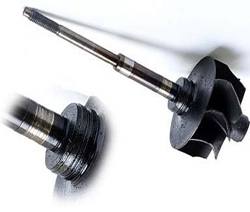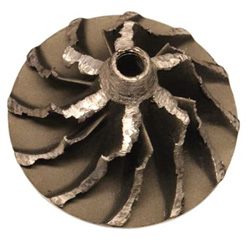Turbocharger Installation Faults.
Most Turbocharger Installation Faults come from oil problems.
Oil is the most critical factor in Turbocharger health.
And a Turbocharger is the most sensitive engine sub-component to oil problems.
Oil starvation after install, and introduced contaminated oil do the most damage.
So Turbocharger Oil Systems are very Important.
And when a turbocharger is diagnosed for an installation fault, if oil is the problem, we find scoring and ‘blueing’ of the shaft.
The evident excessive heat (‘blueing’) and fouled oil damage (scoring), make this an easy diagnosis for the below cases:
In the case of a newly installed Turbocharger: either the CHRA and oil feed line were not pre-primed, or insufficient oil pressure at initial start up.
Or the oil and filter were not changed prior to install, or the engine oil system is contaminated (even after servicing), and needs to be flushed.
Other Common factors in Turbocharger Installation Problems
Aside from the above oil contamination faults, there are a number of other Turbocharger Installation Faults.
Oil Pressure:

Lack of, or Excess oil pressure, both in and out of the CHRA.
– Restricted oil flow into the CHRA will damage the bearings and shaft of the Turbo, with scoring and ‘blueing’ as evidence.
– Excessive oil flow pressure into the CHRA, will force oil out of the CHRA and into the Compressor or Turbine housings.
– Likewise, restricted oil outflow, will force an oil bypass of the oil ‘seals’ in the CHRA.
Foreign Object Damage (FOD):
Foreign Object Damage (FOD), or harm a Turbocharger sustains due to ingestion of foreign matter.
Not just an installation fault, but if a nut or piece of rag is left behind after install in the air/gas system of a turbo, it gets sucked through.
Even small particles can damage the impeller wheel when it spins at 150,000rpm.
Turbine blades spinning at the same rate, can be damaged by carbon deposits ejected from the manifold.
When a Compressor or Turbine Wheel is slightly damaged, it’s usually accompanied by a whistling noise under operation.
And the damage often creates and imbalance in the shaft, leading to excess wear, and eventual(if not immediate) collision of the Compressor Wheel, with the barrel of its housing.

Another type of FOD, is caused by the use of gasket cement or adhesives, on intake ports or flanges.
The use of such voids warranty, as the excess cement can be sucked from the flange into the impeller barrel, or into the CHRA from oil port gaskets.
‘Turbocharger’ Noise and Lack of Power:
Sometimes a Turbocharger fault is assumed when a ‘squealing’ noise is heard, coupled with low throttle response.
There are vacuum hoses (on pneumatically actuated turbos), air pipes (intake, intercooler), and flanges on a turbocharger and associated sub-systems.
The noise may be from air or gas(exhaust) leaking or being sucked in (under vacuum).
These breaches can happen after install where pipe connections and compressor or turbine housing flanges have not been sealed adequately.
As you can see, there are a number of Installation faults that can immediately affect operation or completely destroy a Turbocharger.
For a more comprehensive list of Turbocharger Failure Indicators, click here.
